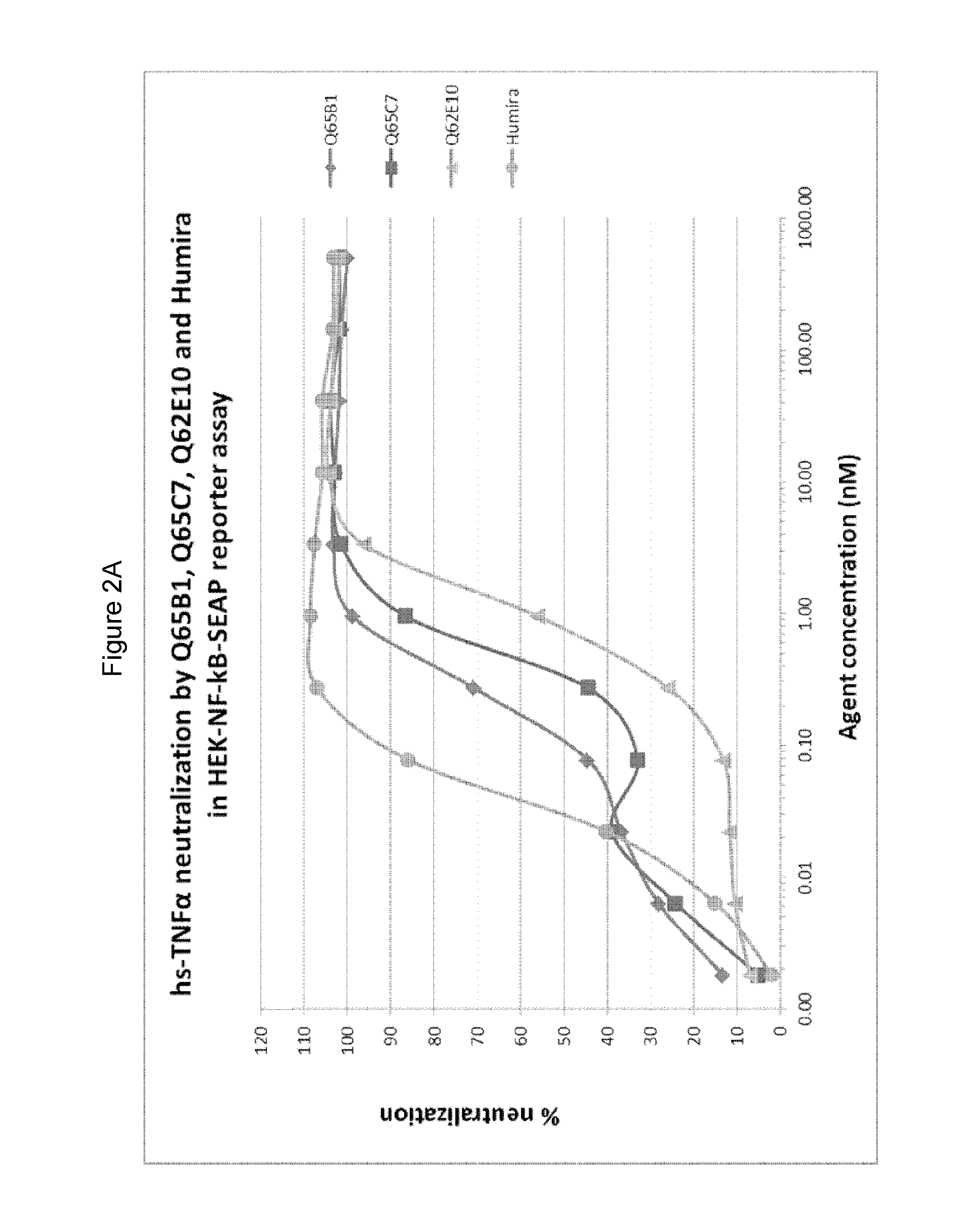Polypeptides
a polypeptide and peptide technology, applied in the field of polypeptides, can solve the problems of affecting the effect of anti-tnf-alpha antibodies, and being difficult to control, and achieve the effect of resisting degradation and/or inactivation, and high potency
- Summary
- Abstract
- Description
- Claims
- Application Information
AI Technical Summary
Benefits of technology
Problems solved by technology
Method used
Image
Examples
example 1
Llama Immunisation, Phage Display, Immunoglobulin Chain Variable Domain Selection and Propagation
[0375]1.1 Immunisation Protocol 1
[0376]Initially, two llamas (llama 33 and llama 35) each received 3 injections (on days 0, 14 and 28) of soluble human recombinant TNF-alpha (100 ug injected intra-muscularly, after mixing 1:1 with Stimune adjuvant) followed by 2 injections (on days 56 and 70) with THP-1 cells that had been pre-activated by incubation with bacterial lipopolysaccharide to increase membrane TNF-alpha expression (107 THP-1 cells injected subcutaneously in 1 ml PBS). A final boosting immunisation with both soluble TNF-alpha and activated THP-1 cells was given on day 84 and blood was drawn 9 days later for the isolation of peripheral blood lymphocytes and extraction of RNA for library construction.
[0377]1.2 Immunisation Protocol 2
[0378]After resting for a period of four months the llamas were re-immunised with two injections a week apart of CHO Flp-In cells that had been engin...
example 2
Primary Evaluation of Periplasmic Supernatants from Randomly Selected Immunoglobulin Chain Variable Domain Clones
[0391]2.1 Propagation and Generation of Periplasmic Extracts for Primary Evaluation
[0392]Phage present in eluates from the first round selections on human TNF-alpha and second round selections on cynomolgus monkey TNF-alpha were used to infect E. coli TG1 cells. Colonies were randomly picked (186 clones from Libraries #33 and #35 into master plates M60-M63; 96 clones from Libraries #33NEW and Library #35NEW into master plate M65) and propagated to generate periplasmic supernatants by sequential centrifugation, resuspension in 1× PBS, freeze-thaw fracture and centrifugation of the propagated cultures (M60-63 and M65 are also referred to as ‘MP60-63’ and ‘MP65’, respectively; periplasmic supernatants are also termed periplasmic fractions (PF) or extracts).
[0393]The periplasmic extracts were screened to test for their ability to (i) inhibit the binding of soluble human TNF-a...
example 3
Evaluation of Purified E. coli Recombinant Variable Domains
[0450]3.1 Production of Selected Variable Domain Clones in E. coli
[0451]DNA sequences of the variable domains selected from M62, M63 and M65 were re-cloned for production in E. coli and then the expressed variable domains were purified as follows.
[0452]Selected variable domains were subcloned from the phagemid vector into the expression plasmid pMEK222 (pMEK222 is a gene3 deleted version of the phagemid pUR8100, and where the cloned variable domain is followed by c-myc and 6His tags, two stop codons and the M13 terminator sequence (see WO2013 / 064701)). The variable domain genes were digested with SfiI and Eco91I and ligated into pMEK222 cut with the same restriction enzymes. E. coli strain BL21 DE3 was transformed by the ligations and plated on LB-agar plates supplemented with ampicillin and 2% glucose. Transformants were screened using colony PCR. Amplifications using the primers M13.rev (SEQ ID NO: 81) and M13.fw (SEQ ID ...
PUM
| Property | Measurement | Unit |
|---|---|---|
| concentration | aaaaa | aaaaa |
| concentrations | aaaaa | aaaaa |
| concentrations | aaaaa | aaaaa |
Abstract
Description
Claims
Application Information
 Login to View More
Login to View More - R&D
- Intellectual Property
- Life Sciences
- Materials
- Tech Scout
- Unparalleled Data Quality
- Higher Quality Content
- 60% Fewer Hallucinations
Browse by: Latest US Patents, China's latest patents, Technical Efficacy Thesaurus, Application Domain, Technology Topic, Popular Technical Reports.
© 2025 PatSnap. All rights reserved.Legal|Privacy policy|Modern Slavery Act Transparency Statement|Sitemap|About US| Contact US: help@patsnap.com



